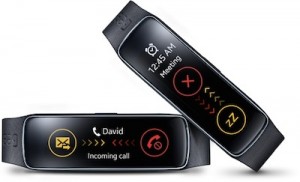 Samsung's Gear Fit.
Samsung's Gear Fit.
As Apple gears up to launch its much-rumored wearable device, new data shows 60 percent of likely adopters of wearable technology want to use their device for health or fitness, according to a survey of 1,000 consumers by ON World.
The report also looked at shipments of wireless personal area devices, a category which includes smartwatches, smart jewelry, pet and child trackers and proximity monitors. ON World predicts 265 million such devices will ship in 2018. Previously, the firm reported that by 2018, 300 million smartwatches will have shipped, total.
"Mobile sensing is quickly becoming a mass market meme," ON World research director Mareca Hatler said in a statement. "Wearables are the largest and fastest growing segment with the most growth coming from general purpose smart devices that integrate multiple sensors as well as multiple communications capabilities."
ON World attributes the trend to the rise of highly integrated, low power wireless chips that can be manufactured cheaply. In particular, a new trend of combo chips with multiple radios could reduce the cost to build a personal area network device by 25 percent. ON World predicts Bluetooth Smart will be the most widely used communication protocol for wearables in the next five years, but WiFi will be the fastest growing.
By analyzing product reviews, ON World found that there are eight times as many smartwatches in the market now than two years ago and four times as many non-smartwatch wearable products. The survey found that 42 percent of likely adopters were most interested in a smartwatch. In May, ON World released data predicting that by next year 19 percent of Americans would own a wearable product.
ON World also asked customers what they would be willing to pay for a smartwatch. They found that 23 percent of potential customers would pay $149 or more if a smartwatch had integrated health and fitness features like blood pressure, heart rate, and activity tracking. Previously released data from the same report indicates that 40 percent of consumers would pay $99 or more for such a device, but only 8 percent would be willing to spend over $299 -- an interesting statistic in light of the recent rumors that Apple will charge $400 for its rumored smartwatch-like wearable.


















